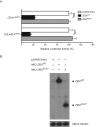Investigating the Molecular Basis of PPCD3: Characterization of ZEB1 Regulation of COL4A3 Expression
- PMID: 27537263
- PMCID: PMC4991021
- DOI: 10.1167/iovs.16-19533
Investigating the Molecular Basis of PPCD3: Characterization of ZEB1 Regulation of COL4A3 Expression
Abstract
Purpose: To investigate the role of the zinc finger e-box binding homeobox 1 (ZEB1) transcription factor in posterior polymorphous corneal dystrophy 3 by demonstrating its ability to regulate type IV collagen gene transcription via binding to putative E2 box motifs.
Methods: Putative E2 box motifs were identified by in silico analysis within the promoter region of collagen, type IV, alpha3 (COL4A3) and collagen, type IV, alpha4 (COL4A4). To test the ability of ZEB1 to bind to each identified E2 box, electrophoretic mobility shift assays were performed by incubating ZEB1-enriched nuclear extracts with DIG-labeled probes containing one of each of the identified E2 box motifs. Dual-luciferase reporter assays were performed to test the effects of ZEB1 on the luciferase activity of COL4A3 and cadherin 1 (CDH1) promoter constructs, and to determine the effect of a ZEB1 truncating mutation on CDH1 promoter activity.
Results: ZEB1 exhibited binding to six of the nine COL4A3 E2 box probes, whereas no binding was observed for either of the two COL4A4 E2 box probes. ZEB1 overexpression resulted in reduced activity of the COL4A3 promoter construct containing all identified E2 box motifs, whereas a truncating ZEB1 mutation led to the loss of ZEB1-dependent repression of the CDH1 promoter.
Conclusions: COL4A3 gene expression is negatively regulated by ZEB1 binding to E2 box motifs in the COL4A3 promoter region. Therefore, the altered expression of type IV collagens, particularly COL4A3, in the corneal endothelium in individuals with PPCD3 is likely due to reduced transcriptional repression in the setting of a single functional ZEB1 allele.
Figures




Similar articles
-
Expression and Function of ZEB1 in the Cornea.Cells. 2021 Apr 16;10(4):925. doi: 10.3390/cells10040925. Cells. 2021. PMID: 33923743 Free PMC article. Review.
-
Analysis of the role of ZEB1 in the pathogenesis of posterior polymorphous corneal dystrophy.Invest Ophthalmol Vis Sci. 2012 Jan 25;53(1):273-8. doi: 10.1167/iovs.11-8038. Invest Ophthalmol Vis Sci. 2012. PMID: 22199242 Free PMC article.
-
Alterations in GRHL2-OVOL2-ZEB1 axis and aberrant activation of Wnt signaling lead to altered gene transcription in posterior polymorphous corneal dystrophy.Exp Eye Res. 2019 Nov;188:107696. doi: 10.1016/j.exer.2019.107696. Epub 2019 Jun 21. Exp Eye Res. 2019. PMID: 31233731
-
Mutations in TCF8 cause posterior polymorphous corneal dystrophy and ectopic expression of COL4A3 by corneal endothelial cells.Am J Hum Genet. 2005 Nov;77(5):694-708. doi: 10.1086/497348. Epub 2005 Sep 14. Am J Hum Genet. 2005. PMID: 16252232 Free PMC article.
-
Digenic Alport Syndrome.Clin J Am Soc Nephrol. 2022 Nov;17(11):1697-1706. doi: 10.2215/CJN.03120322. Epub 2022 Jun 8. Clin J Am Soc Nephrol. 2022. PMID: 35675912 Free PMC article. Review.
Cited by
-
Transcriptomic Profiling of Posterior Polymorphous Corneal Dystrophy.Invest Ophthalmol Vis Sci. 2017 Jun 1;58(7):3202-3214. doi: 10.1167/iovs.17-21423. Invest Ophthalmol Vis Sci. 2017. PMID: 28654985 Free PMC article.
-
Polymorphous corneal dystrophy subtype 3 and keratoconus aggravation after corneal refractive surgery in a three-generation family carrying both ZEB1 and ZNF469 pathogenic variant.Front Genet. 2025 Jun 6;16:1603019. doi: 10.3389/fgene.2025.1603019. eCollection 2025. Front Genet. 2025. PMID: 40547359 Free PMC article.
-
Human-specific genomic evolution of a regulatory network enables fine-tuning of N-cadherin gene expression.Cell Mol Life Sci. 2025 May 9;82(1):196. doi: 10.1007/s00018-025-05725-6. Cell Mol Life Sci. 2025. PMID: 40343501 Free PMC article.
-
Expression and Function of ZEB1 in the Cornea.Cells. 2021 Apr 16;10(4):925. doi: 10.3390/cells10040925. Cells. 2021. PMID: 33923743 Free PMC article. Review.
References
-
- Weiss JS,, Moller HU,, Aldave AJ,, et al. IC3D classification of corneal dystrophies--edition 2. Cornea. 2015; 34: 117–159. - PubMed
-
- Heon E,, Mathers WD,, Alward WL,, et al. Linkage of posterior polymorphous corneal dystrophy to 20q11. Hum Mol Genet. 1995; 4: 485–488. - PubMed
-
- Gwilliam R,, Liskova P,, Filipec M,, et al. Posterior polymorphous corneal dystrophy in Czech families maps to chromosome 20 and excludes the VSX1 gene. Invest Ophthalmol Vis Sci. 2005; 46: 4480–4484. - PubMed
Publication types
MeSH terms
Substances
Supplementary concepts
Grants and funding
LinkOut - more resources
Full Text Sources
Other Literature Sources
Research Materials
Miscellaneous

